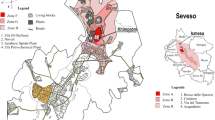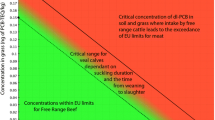Abstract
Hexachlorocyclohexane (HCH) isomers (α-, β- and γ- HCH [lindane]) were recently added to the list of persistent organic pollutants regulated by the Stockholm Convention, and therefore, the legacy of HCH and lindane production has become an issue of global relevance. The production of lindane with the much larger quantities of associated waste isomers has generated large waste deposits and contaminated sites. This article presents an overview of HCH-polluted sites in Brazil as a basis for further activities related to the Stockholm Convention. The locations of HCH stockpiles and contaminated sites in Brazil arising from production and formulation have been compiled and mapped. This shows that the measures taken over the past 25 years have not resulted in remediation of the HCH pollution. An exposure risk study has been summarised for one major site and is included to demonstrate the contemporary relevance of the contamination. Major site remediation efforts are planned at one site but people live close to several other sites, and there is an urgent need of further assessments and remediation to ensure the protection of human health and the environment. The Stockholm Convention requires a systematic approach and should be adopted for the assessment of all sites and appropriate isolation/remediation measures should be facilitated. The appropriate planning of these activities for the production site in Rio de Janeiro could be a positive contribution for Rio+20 highlighting that green economy and sustainable production also include the appropriate management of legacies of historic production of an industrial sector (here the organochlorine industry).



Similar content being viewed by others
Notes
A popular name in Brazil for HCH is ‘powder-drill’.
In particular, ‘Zero hazardous waste not covered by an environmental sound management’
References
Abhilash PC, Singh N (2009a) Seasonal variation of HCH isomers in open soil and plant-rhizospheric soil system of a contaminated environment. Environ Sci Pollut Res Int 16:727–740
Abhilash PC, Singh N (2009b) Withania somnifera Dunal-mediated dissipation of lindane from simulated soil: implications for rhizoremediation of contaminated soils. J Soils Sediments 10:272–282
Anon (2005) Optimism in Chile's and Brazil's chemical industry. Focus on Surfactants, 2005 (6)
Bodenstein G (1972) Lindane, monograph of an insecticide. In: Uhlmann E, Schillinger V, im Breisgau F (eds) Chapter disposal of wastes from lindane manufacture, 134, 1972
Braga AMCB. (1998). Contaminação ambiental por hexaclorociclohexano em escolares na “Cidade dos Meninos”, Duque de Caxias, Rio de Janeiro. M.Sc. Thesis. Health Ministry of Brazil, FIOCRUZ
Braga AMCB, Krauss T, dos Santos CRR, de Souza PM (2002) PCDD/F-contamination in a hexachlorocyclohexane waste site in Rio de Janeiro, Brazil. Chemosphere 46:1329–1333
Forter M (2012) Interview with Peter Donath. www.martinforter.ch
Fróes-Asmus CIR, Alonzo HGA, Palácios M, Silva AP, Filhote MIF, Buosi B, Câmara VM. (2008). Assessment of human health risk from organochlorine pesticide residues in “Cidade dos Meninos”, Duque de Caxias, Rio de Janeiro, Brazil Cad. Saúde Publica, Rio de Janeiro 24(4):755–766. http://www.scielo.br/pdf/csp/v24n4/05.pdf
Götz R, Sokollek V, Weber R (2012) The dioxin/POPs legacy of pesticide production in Hamburg: part 2: waste deposits and remediation of Georgswerder landfill. Env Sci Pollut Res. doi:10.1007/s11356-012-0986-x
IPT (2009) Instituto de Pesquisas Tecnológicas do Estado de São Paulo (IPT). Relatório técnico IPT nº 115053-205—Desenvolvimento de alternativas Tecnológicas para tratamento de solo e água subterrânea, contaminados com HCH (Hexaclorociclohexano), na área do Bota-fora situado à Rua Cápua, Santo André, SP. São Paulo, 2009
Jit S, Dadhwal M, Kumari H, Jindal S, Kaur J, Lata P, Niharika N, Lal D, Garg N, Gupta SK, Sharma P, Bala K, Singh A, Vijgen J, Weber R, Lal R (2010) Evaluation of hexachlorocyclohexane contamination from the last lindane production plant operating in India. Env Sci Pollut Res 18(4):586–597
La Laina Cunha AC, Ruiz MS, C Echevenguá Teixeira (2010). Environmental assessment of remediation technologies: an analytical framework for a hexachlorocyclohexane (HCH) contaminated site in Brazil. In: proceedings: 2nd International Conference on "Hazardous and Industrial Waste Management", Chania, Technical University of Crete, Greece, 5–8 October 2010
Li Y-F (1999) Global technical hexachlorocyclohexane usage and its contamination consequences in the environment: from 1948 to 1997. Sci Total Environ 232(3):121–158
Li Y-F, Trevorscholtz M, Van Heyst BJ (2003) Global gridded emission inventories of beta-hexachlorocyclohexane. Environ Sci Technol 37:3493–3498
Mello, JL. 1999. Avaliação da contaminação por HCH e DDT dos leites de vaca e humano provenientes da “Cidade dos Meninos”, Duque de Caxias—RJ. M.Sc. Thesis. Health Ministry of Brazil, FIOCRUZ
Oliveira RM. 1994. Estudo da contaminação do solo e pasto causada por hexaclorociclohexanos (HCH) na “Cidade dos Meninos” em Duque de Caxias, RJ. M.Sc. Thesis. Health Ministry of Brazil, FIOCRUZ
Osterreicher-Cunha P, Langenbach T, Torres JP, Lima AL, de Campos TM, Vargas Júnior Edo A, Wagener AR (2003) HCH distribution and microbial parameters after liming of a heavily contaminated soil in Rio de Janeiro. Environ Res 93:316–327
Stockholm Convention (2008) Toxic interactions between persistent organic pollutants. 4th Meeting of the Persistent Organic Pollutants Review Committee Geneva, 13–17 October 2008
Stockholm Convention (2009) Report of the Conference of the Parties of the Stockholm Convention on Persistent Organic Pollutants on the work of its fourth meeting. UNEP/POPS/COP.4/38. 8 May 2009
Torres J. (2009) Environmental (in)justice in Brazil: HCH and other POP contaminated sites in a social-ecological point of view. Presentation at the 10th International HCH and Pesticide Forum, 07–10 September 2009, Brno, Czech Republic. http://www.hchforum.com/10th/presentations/pdf/07-01_Torres.pdf
Vijgen J (2006a) The legacy of lindane HCH isomer production. Main report. IHPA, January 2006. http://ew.eea.europa.eu/Agriculture/Agreports/obsolete_pesticides/lindane_production.pdf
Vijgen J (2006b). The legacy of lindane HCH isomer production. Annexes. IHPA, January 2006. http://ew.eea.europa.eu/Agriculture/Agreports/obsolete_pesticides/lindane_annexes.pdf
Vijgen J, Abhilash PC, Li Y-F, Lal R, Forter M, Torres J, Singh N, Yunus M, Tian C, Schäffer A, Weber R (2011) HCH as new Stockholm Convention POPs—a global perspective on the management of lindane and its waste isomers. Env Sci Pollut Res, 18:152–162. http://www.springerlink.com/content/g62g810418512421/fulltext.pdf
Weber R (2007) Relevance of PCDD/PCDF formation for the evaluation of POPs destruction technologies—review on current status and assessment gaps. Chemosphere 67:109–117
Weber R, Varbelow G (2012) The dioxin/POPs legacy of pesticide production in Hamburg: part 1—securing of the production area. Env Sci Pollut Res. doi:10.1007/s11356-012-1011-0
Weber R, Gaus C, Tysklind M, Johnston P, Forter M, Hollert H, Heinisch H, Holoubek I, Lloyd-Smith M, Masunaga S, Moccarelli P, Santillo D, Seike N, Symons R, Torres JPM, Verta M, Varbelow G, Vijgen J, Watson A, Costner P, Wölz J, Wycisk P, Zennegg M. (2008) Dioxin—and POP-contaminated sites—contemporary and future relevance and challenges. Env Sci Pollut Res 15:363–393. http://www.springerlink.com/content/0q10km8582605r1x/fulltext.pdf
World Chlorine council (2007) Sustainability commitments and actions. http://www.worldchlorine.org/sustainability/sustain_07/wcc_report07.pdf
Wycisk P, Stollberg R, Neumann C, Gossel W, Weiss H, Weber R (2012) Integrated methodology for assessing the HCH groundwater pollution at the multi-source contaminated mega-site Bitterfeld/Wolfen. Env Sci Pollut Res. doi:10.1007/s11356-012-0963-4
Acknowledgments
The authors are indebted to Mr. Andre Junqueira who provided valuable information regarding the Matarazzo site and numerous contributions to the International HCH and Pesticide Association database to uncover the global HCH pollution. Thanks to Tim Newfield for corrective reading. João PM Torres is an advanced fellow at the Mount Sinai School of Medicine and is partially funded by grant 1D43TW00640 from Fogarty-NIH and CNPq (Brazilian Research Council) and FAPERJ (Rio de Janeiro State Agency for Research).
Author information
Authors and Affiliations
Corresponding author
Additional information
Responsible editor: Philippe Garrigues
This article also belongs to the series ‘Dioxin and POPs contaminated sites’ edited by Roland Weber, Mats Tysklind and Caroline Gaus (Weber et al. 2008).
Rights and permissions
About this article
Cite this article
Torres, J.P.M., Fróes-Asmus, C.I.R., Weber, R. et al. HCH contamination from former pesticide production in Brazil—a challenge for the Stockholm Convention implementation. Environ Sci Pollut Res 20, 1951–1957 (2013). https://doi.org/10.1007/s11356-012-1089-4
Received:
Accepted:
Published:
Issue Date:
DOI: https://doi.org/10.1007/s11356-012-1089-4




